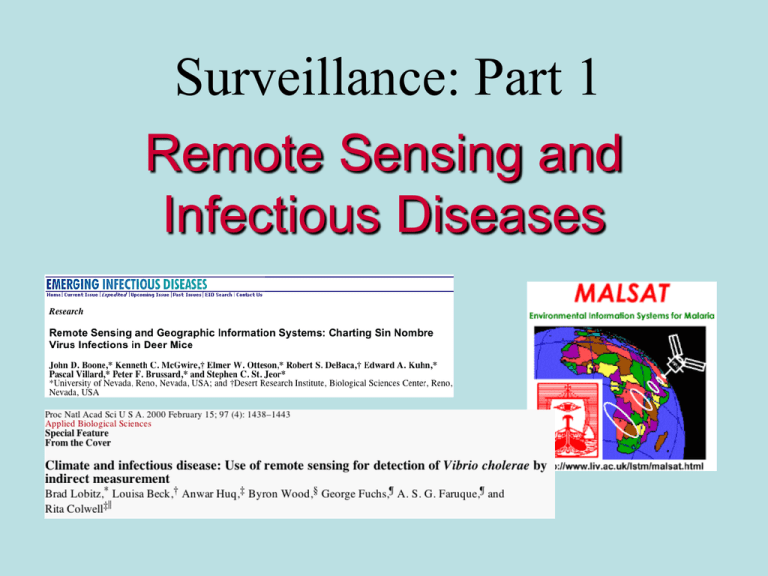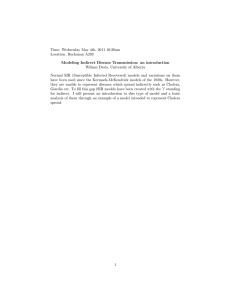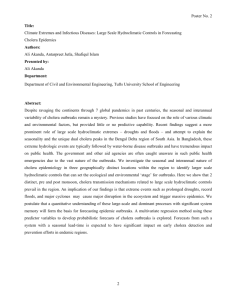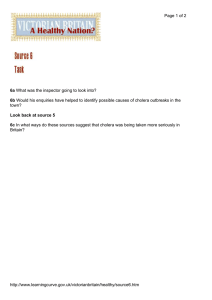Surveillance: Part 1 Remote Sensing and Infectious Diseases
advertisement

Surveillance: Part 1 Remote Sensing and Infectious Diseases Courtesy NASA The Earth At Night WHAT YOU CAN LEARN FROM SENSORS ON SPACECRAFT THAT LOOK INWARD AT THE EARTH Satellites That Look At Earth ACRIMSAT Aqua Aura CALIPSO CHAMP CloudSAT DSCVR ERBS GOES-L GOES-M GPM GRACE ICESat JASON-1 LANDSAT 7 LDCM NMP EO-1 NOAA-L POES NOAA-M POES NPP QuikSCAT SAGE-3 (Meteor) Seawinds (ADEOS-11) SORCE SRTM Terra TOMS-EP TOPEX/Poseidon TRMM UARS Satellites Monitor: Urbanization* Cloud cover Rainfall* Temperature (ocean and land masses)* Total Stratospheric Ozone Surface Ozone Vegetation types* Land and sea height Artificial radiance (electric lights, etc.) Magnetic fields Sea surface wind speeds Air quality* Lightning strikes *Important factors influencing the distribution of infectious agents http://www.soi.city.ac.uk/~dk708/pg3_2.htm A good web site for over-view of remote sensing and infectious diseases CHAART (Center for Health Applications of Aerospace Related technologies) Cholera Diarrhea Ebola Filariasis Hantavirus Helminthiases Leishmaniasis Lyme Malaria Rabies Rift Valley fever Schistosomiasis Tick-borne diseases Yellow Fever http://geo.arc.nasa.gov/sge/health/rsgisbib.html Remote Sensing & Land-Use Changes PREDICTING THE RISKS OF MOSQUITO-BORNE DISEASES FROM LAND-USE CHANGE (Northwestern Thailand) Landsat 1989 Landsat 2000 Objective: The aim of this project is to provide a predictive model of the effects of land use change on the prevalence of mosquito-borne disease in Thailand, and a methodology for the development of similar models for other regions and diseases.*Expected achievements *1. The project will develop a standardised methodology for predicting changes in disease risk that arise as a result of changes in land use. The methodology will be made freely available to public health authorities, governments and NGOs. It will be applicable to other regions and in other disease contexts.*2. The project will improve our general understanding of the effects of humaninduced environmental change on human health, particularly with respect to mosquito-borne diseases. S. Vanwambeke and E. Lambin, project directors Many Infectious Diseases Are Transmitted At the Ecotone The Ecotone* *The edge effect The Ecotone And Infectious Diseases Viruses: Rabies Yellow Fever* Lassa Fever Ebola Hanta* Influenza Bacteria: Cholera* Lyme Disease* Protozoa: Malaria* Trypanosomiasis Helminths: Schistosomiasis* *Remote sensing projects Lyme Disease And Remote Sensing Lyme Disease Maintenance: Urbanization and De-forestation Westchester County, NY* *Savanna-like ecology Perspective Remote Sensing and Human Health: New Sensors and New Opportunities Louisa R. Beck,*† Bradley M. Lobitz,† and Byron L. Wood† *California State University, Monterey Bay, California, USA; †NASA Ames Research Center, Moffett Field, California, USA Lyme Disease In Westchester County, NY Figure 1. Landsat Thematic Mapper (TM) satellite data for a 6x6-km area in Westchester County, New York. Shown are the raw data (a), as well as products (e.g., maps) derived from the data (b-d) that might be used for modeling Lyme disease transmission risk. a) Raw Landsat TM image composed of bands 5, 4, and 3 (midinfrared, near-infrared, and red bands). Vegetation is shown in shades of green, with bare soil and urban areas shown in shades of pink and purple. The spatial resolution of these data is 30x30 m. b) Map showing contiguous forest patches, derived from a Landsat TM classification. Colors represent discrete patches, with white indicating the absence of contiguous forest. c) A 12-class land cover map derived from the Landsat TM data. d) Composite image of three spectral indices derived from the Landsat TM data, showing the contributions of scene brightness in red, greenness in green, and wetness in blue. Cholera and Remote Sensing The First Cholera Outbreak Asiatic Cholera Pandemic of 1817-23 Note: This cholera pandemic, occurring during John Snow's early life, did not reach the British isles. This was the first great cholera pandemic of the nineteenth century. It was unprecedented in its fury, affecting almost every country in Asia. While early cases of cholera were reported from Purneah (now Purnia) in Bihar (state in east India) in early 1816, the pandemic is believed to have originated in the town of Jessore (near Calcutta) in August 1817. A civil surgeon, reporting on the high incidence of a severe gastrointestinal disease among his patients, drew attention to the source of contagion -- contaminated rice. Amidst attacks of vomiting and diarrhea thousands of people collapsed and died, including hundreds of British soldiers transiting through Bengal. Cholera then spread rapidly across the country and, in December 1818, arrived in Sri Lanka (Ceylon). Second Cholera Outbreak London, 1832 John Snow Drawings by: Thomas Shapter Information from: Shapter T (1849). The history of cholera in Exeter in 1832. The book was most recently reprinted in 1971 by SR Publishers of Wakefield, but is now out of print. This information was originally compiled for a History of Medicine course at St Loye's School of Health Studies and is now provided here for general information and use. The information was compiled by : Graeme Barber John Snow and Cholera Now famous pub! Infamous pump! http://www.medicalecology.org/water/cholera/w_cholera.html New Cholera Outbreaks Occur In Communities Adjacent To Estuaries.* WHY? * The estuary is an ecotone between fresh water and salt water ecosystems In Vitro Growth Requirements For Vibrio cholerae: 1. Low salt 2. Enriched nutrients 3. 20o C* *Most pathogens of humans require a temperature of 37O C Vibrio cholerae and its relatives are marine microbes fully integrated into estuarine food webs. Environmental Conditions Favoring Growth Of Vibrio: 1. Low salinity of estuary 2. Nutrient-loading of estuary o 3. 20 C Zooplankton Blooms are Associated With Outbreaks Of Cholera In India Monsoon “Wedding” Weather patterns and cholera outbreaks are linked o 2D animation of the Asian Monsoon (2.8 MB Quicktime 3D animation of the Asain Monsoon (big-4.5 MB Quicktime) http://daac.gsfc.nasa.gov/CAMPAIGN_DOCS/atmospheric_dynamics/ad_images_dao_animations.html Monsoons: 1. lower the salinity of the estuary 2. bring nutrients to the estuary 3. raise the ambient water temperature of the estuary Cholera Project institution: University of Maryland Biotechnology Institute, College Park, Maryland Principal investigators: Dr. Rita Colwell1 and Dr. Anwar Huq1 Co-investigators: B. Lobitz2, L. Beck2, B. Wood2 1 2 University of Maryland Biotechnology Institute CHAART, NASA Ames Research Center Phytoplankton Bloom Note: This article was corrected on April 16, 2002: in Appendix A, the country developing ASTER was changed to Japan/USA. Perspective Remote Sensing and Human Health: New Sensors and New Opportunities Louisa R. Beck,*† Bradley M. Lobitz,† and Byron L. Wood† *California State University, Monterey Bay, California, USA; †NASA Ames Research Center, Moffett Field, California, USA Figure 2. Datasets used to model the temporal patterns of cholera outbreaks in Bangladesh. a) Advanced Very High Resolution Radiometer (AVHRR) satellite image showing the mouth of the Ganges River and the Bay of Bengal. Vegetation is shown in shades of red and water in shades of blue. The spatial resolution of these data is 1.1 km. b) Sea surface temperature data, derived from AVHRR thermal bands. Temperatures range from low (purple) to high (red). c) Sea surface height data, derived from TOPEX/Poseidon satellite data. The spatial resolution of these data is 1 degree. d) Image derived from the Sea-viewing Wide Field-of-view Sensor (SeaWiFS) showing chlorophyll concentration, ranging from low (blue) to high (red). These satellite data have a nominal spatial resolution of 1.1 km. International Ocean Colour Coordinating Group Coastal Zone Colour Scanner MEdium Resolution Imaging Spectrometer Moderate Resolution Imaging Spectroradiometer Phytoplankton bloom in the Bay of Bengal during the northeast monsoon and its intensification by cyclones P. N. Vinayachandran and Simi Mathew MOS satellite Centre for Atmospheric and Oceanic Sciences, Indian Institute of Science, Moderate Optoelectrical Scanner Bangalore, India Remote sensing of ocean colour from space began in 1978 with the successful launch of NASA's Coastal Zone Color Scanner (CZCS). Despite the fact that CZCS was an experimental mission intended to last only one year, the sensor continued to generate a valuable time-series of data over selected test sites until early 1986. Ten years passed before othere sources of ocean-colour data became available with the launch of MOS, OCTS and POLDER in 1996, and SeaWiFS in 1997. Several new ocean-colour sensors have recently been launched and still more are planned for the near future by various space agencies. There are two types of orbits for Earth observation satellites, polar orbiting and geostationary. Polar-orbiting satellites typically operate at an altitude of around 800 km, with a revisit time of 2-3 days, whereas geostationary satellites operate in time scales of hours, which could theoretically provide data on the diurnal variation in phytoplankton abundance and productivity. SeaWiFS Sea-viewing Wide Field-of-view Sensor Malaria And Remote Sensing Adult Anopheles dirus taking a blood meal from one of the authors (RWG) Every Year, 3 million People Die From Malaria. 1 Million Die In Africa, Alone. Most Are Children Ecological Settings For Malaria Transmission Climate Change Will “Re-shuffle The Deck” With Respect To The Distribution Of Plants And Animals Environmental Health Perspectives Volume 107, Number 5, May 1999 By Helen Briggs BBC News Online science reporter Outbreaks of human malaria, butterflies beset with parasites, disease-stricken corals, and trees overgrown with fungus. That is the gloomy picture of tomorrow's planet An Integrated Assessment Framework for Climate Change and Infectious Diseases Nathan Y. Chan,1 Kristie L. Ebi,2 Fraser Smith,3 Thomas F. Wilson,2 and Anne E. Smith4 painted by scientists in the United States. Global Climate Change and Infectious Diseases R. Colwell,* P. Epstein,† D. Gubler,‡ M. Hall,§ P. Reiter,‡ J. Shukla¶, W. Sprigg,# E. Takafuji,** and J. Trtanj§ *University of Maryland Biotechnology Institute, College Park, Maryland, USA; †Harvard Medical School, Boston, Massachusetts, USA; ‡Centers for Disease Control and Prevention, Atlanta, Georgia, USA; §National Oceanic and Atmospheric Administration, Washington, D.C., USA; ¶Institute of Global Environment and Society, Inc., Calverton, Maryland, USA; #National Research Council, Washington, D.C., USA; **Walter Reed Army Institute of Research, Washington, D.C., USA 1Talus Solutions, Inc., Mountain View, CA 94041 USA 2EPRI, Palo Alto, CA 94304 USA 3Datafusion, Inc., San Francisco, CA 94107 USA 4Charles River Associates, Inc., Washington, DC 20005 USA Remote sensing may be able to tell us who moved and to where. Terra Satellite Courtesy: NASA Terra satellite



